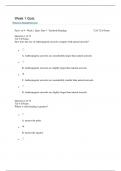Ersc 180 - Study guides, Class notes & Summaries
Looking for the best study guides, study notes and summaries about Ersc 180? On this page you'll find 43 study documents about Ersc 180.
All 43 results
Sort by
ERSC 180 Part 1 of 4 - Week 1 Quiz: Part I Questions and Answers | Latest 2023/2024 (Graded A+)
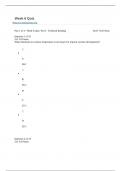
-
ERSC 180 Week 6 Quiz Week 6 Quiz Return to Assessment Lis
- Exam (elaborations) • 24 pages • 2024
-
- $9.49
- + learn more
Week 6 Quiz Return to Assessment List Part 1 of 4 - Week 6 Quiz: Part I - Textbook Reading 66.0/ 72.0 Points Question 1 of 33 3.0/ 3.0 Points What minimum sea surface temperature is necessary for tropical cyclone development? A. 30oC B. 25oC C. 27oC D. 32oC Question 2 of 33 3.0/ 3.0 Points When is the Atlantic hurricane season? A. May through September B. July through October C. June through November
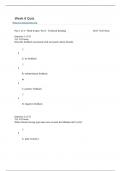
-
ERSC 180 Week 8 Quiz Questions and Answers | Latest 2023/2024 (Graded A+)
- Exam (elaborations) • 23 pages • 2024
-
- $9.49
- + learn more
Week 8 Quiz Return to Assessment List Part 1 of 4 - Week 8 Quiz: Part I - Textbook Reading 60.0/ 72.0 Points Question 1 of 33 3.0/ 3.0 Points Describe feedback associated with increased carbon dioxide. A. no feedback B. indeterminant feedback C. positive feedback D. negative feedback Question 2 of 33 3.0/ 3.0 Points What climate forcing type takes into account the Milankovich Cycle? A. plate tectonics

-
ERSC 180 Week 3 Study Questions and Answers | Latest 2023/2024 (Graded A+)
- Exam (elaborations) • 24 pages • 2024
-
- $10.49
- + learn more
Week 3 Quiz Return to Assessment List Part 1 of 4 - Week 3 Quiz: Part I - Textbook Reading 54.0/ 72.0 Points Question 1 of 33 0.0/ 3.0 Points What reduces the buoyancy of rising air parcels by mixing in cooler air from the surrounding environment? A. convection B. adiabatic C. condensation D. entrainment Feedback:The displacement of air parcels are dependent upon differences in density of the air and the surrounding environment. See Chapter 5, Part C: Air Stabilit...
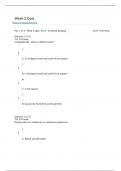
-
ERSC 180 Week 3 Quiz Part 1 of 4 - Week 2 Quiz: Part I - Textbook Reading 66.0/ 72.0 Points
- Exam (elaborations) • 24 pages • 2024
-
- $9.49
- + learn more
3.0/ 3.0 Points Geographically, where is albedo lowest? A. at 30 degrees north and south of the equator B. at 60 degrees north and south of the equator C. at the equator D. nearest the North Pole and South Pole Question 2 of 33 3.0/ 3.0 Points During what two mo
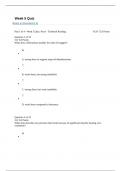
-
ERSC 180 Week 5 Quiz Return to Assessment List Part 1 of 4 - Week 5 Quiz: Part I
- Exam (elaborations) • 23 pages • 2024
-
- $9.49
- + learn more
Part 1 of 4 - Week 5 Quiz: Part I - Textbook Reading 45.0/ 72.0 Points Question 1 of 33 3.0/ 3.0 Points What does a Richardson number less than 30 suggest? A. strong shear to support supercell thunderstorms B. weak shear, but strong instability C. strong shear, but weak instability D. weak shear compared to buoyancy Question 2 of 33 3.0/ 3.0 Points What term describes low pressure that forms because of significant daytime heating over continents? A. thermal l...
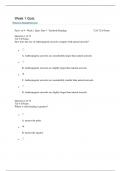
-
ERSC 180 Week 1 Study Week 1 Study Questions and Answers | Latest 2023/2024 (Graded A+)
- Exam (elaborations) • 19 pages • 2024
-
- $9.49
- + learn more
Week 1 Quiz Return to Assessment List Part 1 of 4 - Week 1 Quiz: Part I - Textbook Reading 72.0/ 72.0 Points Question 1 of 33 3.0/ 3.0 Points How does the size of anthropogenic aerosols compare with natural aerosols? • A. Anthropogenic aerosols are considerably larger than natural aerosols. • B. Anthropogenic aerosols are slightly larger than natural aerosols. • C. Anthropogenic aerosols are considerably smaller than natural aerosols. • D. Anthropogenic aerosols are slightly...
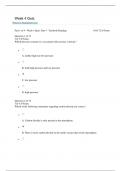
-
ERSC 180 Week 3 Study Questions and Answers | Latest 2023/2024 (Graded A+)
- Exam (elaborations) • 21 pages • 2024
-
- $10.49
- + learn more
Week 2 Quiz Return to Assessment List Part 1 of 4 - Week 2 Quiz: Part I - Textbook Reading 66.0/ 72.0 Points Question 1 of 33 3.0/ 3.0 Points Geographically, where is albedo lowest? • A. at 30 degrees north and south of the equator • B. at 60 degrees north and south of the equator • C. at the equator • D. nearest the North Pole and South Pole Question 2 of 33 3.0/ 3.0 Points During what two months do we experience equinoxes? • A. March and December • B. June and S...
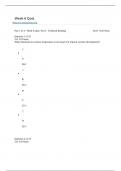
-
ERSC 180 Week 6 Quiz Week 6 Quiz Return to Assessment List Part 1 of 4 - Week 6 Quiz: Part I
- Exam (elaborations) • 24 pages • 2024
-
- $10.49
- + learn more
Part 1 of 4 - Week 6 Quiz: Part I - Textbook Reading 66.0/ 72.0 Points Question 1 of 33 3.0/ 3.0 Points What minimum sea surface temperature is necessary for tropical cyclone development? A. 30oC B. 25oC C. 27oC D. 32oC Question 2 of 33 3.0/ 3.0 Points When is the Atlantic hurricane season? A. May through September B. July through October C. June throug
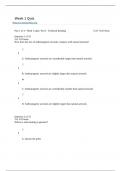
-
ERSC 180 Week 1 Quiz Return to Assessment List Part 1 of 4 - Week 1 Quiz: Part I -
- Exam (elaborations) • 23 pages • 2024
-
- $9.49
- + learn more
Question 1 of 33 3.0/ 3.0 Points How does the size of anthropogenic aerosols compare with natural aerosols? A. Anthropogenic aerosols are considerably larger than natural aerosols. B. Anthropogenic aerosols are slightly larger than natural aerosols. C. Anthropogenic aerosols are considerably smaller than natural aerosols. D. Anthropogenic aerosols are slightly larger than natural aerosols. Question 2 of 33 3.0/ 3.0 Points Where is solar heating is greatest? A. ...

How much did you already spend on Stuvia? Imagine there are plenty more of you out there paying for study notes, but this time YOU are the seller. Ka-ching! Discover all about earning on Stuvia

